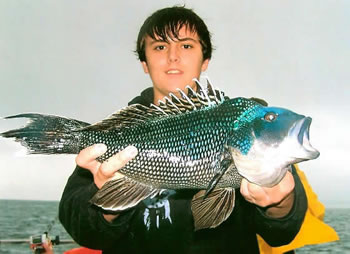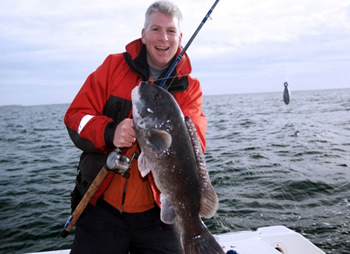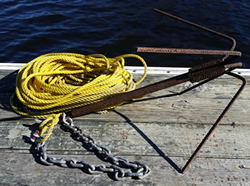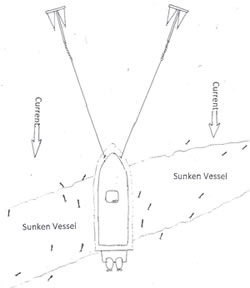By Hugh Carberry, Principal Biologist Fall is the best time of the year to catch black sea bass and tautog on New Jersey's artificial reefs. Creel limits have increased and they can be found in great numbers on all 15 reefs. Every angler can limit out if proper technique and equipment is utilized. The intent of this article is to layout proven techniques and identify key equipment that will result in coolers full of fish and a successful day. Fall 2015 Black Sea Bass and Tautog Regulations
Black sea bass and tautog (also known as blackfish) are directly associated with reefs, and catching these species is all about location: you must be anchored in the right spot! Within New Jersey's Reef Network there are thousands of previously deployed structures called "patch reefs" that hold these fish. Any angler targeting black sea bass and tautog should consult the Guide to Fish and Diving New Jersey Reefs (2009). Coordinates of these patch reefs are listed in the guide. It should be noted that all latitude and longitude numbers for the deployed reef structures are listed in the DD MM.MMM' format and the map datum is World Geodetic System, 1984 (WGS 84). It is imperative that anglers have their GPS set up in this format to quickly and accurately find these structures. Long Range Aid to Navigation (LORAN) is no longer in use. Anchoring Over Structure There are basically two areas on every reef: one designated for drift fishing and the other for anchoring. If it is numbers of fish you are looking for, anchoring over a sunken vessel or an army tank is the best way to quickly catch a limit.
Prior to going directly over, and depending on the depth of the water, the grappling anchor is then thrown overboard and allowed to drag along the bottom until it hooks into the submerged structure. This may take several attempts. Once hooked, the fishing vessel is moved gently forward, being careful not to pull the grappling anchor from the structure. The anchor line is then firmly secured to a bow cleat.
Terminal Tackle
Black sea bass are easier to catch than tautog and the key to catching a limit is to use simple terminal tackle.
Store-bought top and bottom rigs made of twisted stainless steel wire work well, but if you want to increase your chances of catching a limit the best thing to do is to construct your own from 30-pound mono leader. All you need to do is tie two dropper loops on a section of mono and add two 4.0 offset bait keeper hooks, add a swivel at the top of the rig with a Palomar Knot and tie an overhand knot at the bottom to hold your sinker.
This is a rig that black sea bass won't shy away from. Keeping your terminal tackle setup simple pays dividends with black sea bass.
The dropper loop rig identified above fitted with black Mustad Virginia 4.0 size hooks will catch tautog, but if you want to dramatically increase your chances of getting a limit use a tandem hook rig. This tandem rig is a sure thing for higher hook-up percentages. Tautog are notorious for being difficult to hook and many consider hooking them an art form. The tandem rig places two hooks in the vicinity of their fleshy mouth and a hard hook set will drive one if not both hooks home. Setting the hook is where the art form comes into play. Tautog bites basically feel like small pecks; setting the hook while the fish is pecking is the key to catching. Their mouth is small in relation to their body size and split-second timing is required to be successful.
Baits
Baits for black sea bass and tautog include salted or fresh surf clam and squid, but green crabs, fiddler crabs and hermit crabs work especially well for tautog. If it is tautog you are after, have an ample supply of these crustaceans.
Rods and Reels
The best rod and reel combo for black sea bass and tautog should be capable of handling 30-40 lb. braid. Braided line allows the angler to put more pressure on the fish to stop it from swimming into reef structure. The rod should be 6 to 7 feet in length with a fast to extra-fast action. The rod should be beefy enough to muscle the fish away from the structure as it attempts to swim in.
Braided lines have a thinner diameter with less water resistance and allow the use of lighter sinkers. By far the greatest advantage though is less stretch which translates into better telegraphed strikes and more hook setting power.
High speed conventional reels are a must to retrieve these fish quickly from the structure before they swim in reef structure and become wedged in.
However, even when the appropriate equipment and technique is utilized, black sea bass and tautog will occasionally swim into reef structure and hold tight. When this happens, the best thing to do is to give the fish some line and hope it swims free when it feels the decreased pressure. This technique works 50 percent of the time.
New Jersey's Reef Network is the prime location to target black sea bass and tautog during the fall. Do your homework before any reef excursion and have several alternate locations preprogrammed in your GPS unit. If you get to your predetermined location and there is another boat there, show proper reef fishing etiquette and anchor up a good distance away or move to another structure all together. There are plenty of other structures to fish on.
One more word about army tanks within New Jersey's reef system: there are hundreds of military tanks (M60s and Armored Personnel Carriers) which are probably the most underutilized structure for black sea bass and tautog. Mastering the double anchoring technique is required to remain directly over top of these structures because of their size. Try an army tank on your next trip you will not be disappointed. Tight lines!
RELATED PAGES
New Jersey's Artificial Reef Program
|
|||||||||||
|
||
|
|
||
|
||
| |
||




